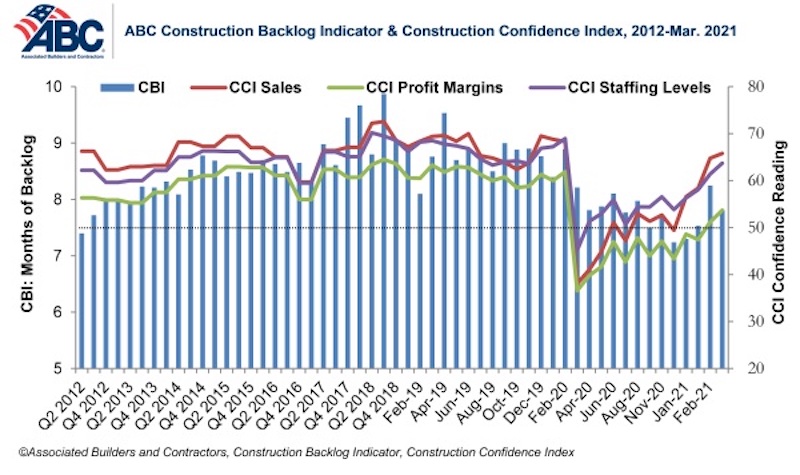Associated Builders and Contractors reported today that its Construction Backlog Indicator fell to 7.8 months in March, according to an ABC member survey conducted from March 22 to April 5, a decrease of 0.4 months from both the February 2021 and March 2020 readings.
ABC’s Construction Confidence Index readings for sales, profit margins and staffing levels increased in March. All three indices remain above the threshold of 50, indicating expectations of growth over the next six months.
“There are two countervailing forces influencing backlog,” said Basu. “On the one hand, design work on new projects declined during most of the pandemic. Some of this is attributable to the need to socially distance, risk aversion and the jarring effects of the crisis on commercial real estate. The result has been fewer projects presently available for bid, which is consistent with declining backlog.
“On the other hand, the surprisingly strong economic recovery has brought projects that seemed dead back to life,” said Basu. “The boom in e-commerce and other tech segments has also produced greater levels of demand for construction of fulfillment and data centers. The overall result is that backlog is roughly where it was six months ago. Given that contractors remain confident regarding sales, employment and profit margins over the balance of the year, the expectation is that more projects will enter the design phase, bidding opportunities are set to rise and at some point backlog will reestablish an upward trajectory.”
Click here for a short video from ABC’s chief economist to see what the latest survey data mean for the construction industry.
Related Stories
Market Data | Oct 31, 2016
Nonresidential fixed investment expands again during solid third quarter
The acceleration in real GDP growth was driven by a combination of factors, including an upturn in exports, a smaller decrease in state and local government spending and an upturn in federal government spending, says ABC Chief Economist Anirban Basu.
Market Data | Oct 28, 2016
U.S. construction solid and stable in Q3 of 2016; Presidential election seen as influence on industry for 2017
Rider Levett Bucknall’s Third Quarter 2016 USA Construction Cost Report puts the complete spectrum of construction sectors and markets in perspective as it assesses the current state of the industry.
Industry Research | Oct 25, 2016
New HOK/CoreNet Global report explores impact of coworking on corporate real rstate
“Although coworking space makes up less than one percent of the world’s office space, it represents an important workforce trend and highlights the strong desire of today’s employees to have workplace choices, community and flexibility,” says Kay Sargent, Director of WorkPlace at HOK.
Market Data | Oct 24, 2016
New construction starts in 2017 to increase 5% to $713 billion
Dodge Outlook Report predicts moderate growth for most project types – single family housing, commercial and institutional building, and public works, while multifamily housing levels off and electric utilities/gas plants decline.
High-rise Construction | Oct 21, 2016
The world’s 100 tallest buildings: Which architects have designed the most?
Two firms stand well above the others when it comes to the number of tall buildings they have designed.
Market Data | Oct 19, 2016
Architecture Billings Index slips consecutive months for first time since 2012
“This recent backslide should act as a warning signal,” said AIA Chief Economist, Kermit Baker.
Market Data | Oct 11, 2016
Building design revenue topped $28 billion in 2015
Growing profitability at architecture firms has led to reinvestment and expansion
Market Data | Oct 4, 2016
Nonresidential spending slips in August
Public sector spending is declining faster than the private sector.
Industry Research | Oct 3, 2016
Structure Tone survey shows cost is still a major barrier to building green
Climate change, resilience and wellness are also growing concerns.
Industry Research | Sep 27, 2016
Sterling Risk Sentiment Index indicates risk exposure perception remains stable in construction industry
Nearly half (45%) of those polled say election year uncertainty has a negative effect on risk perception in the construction market.




















